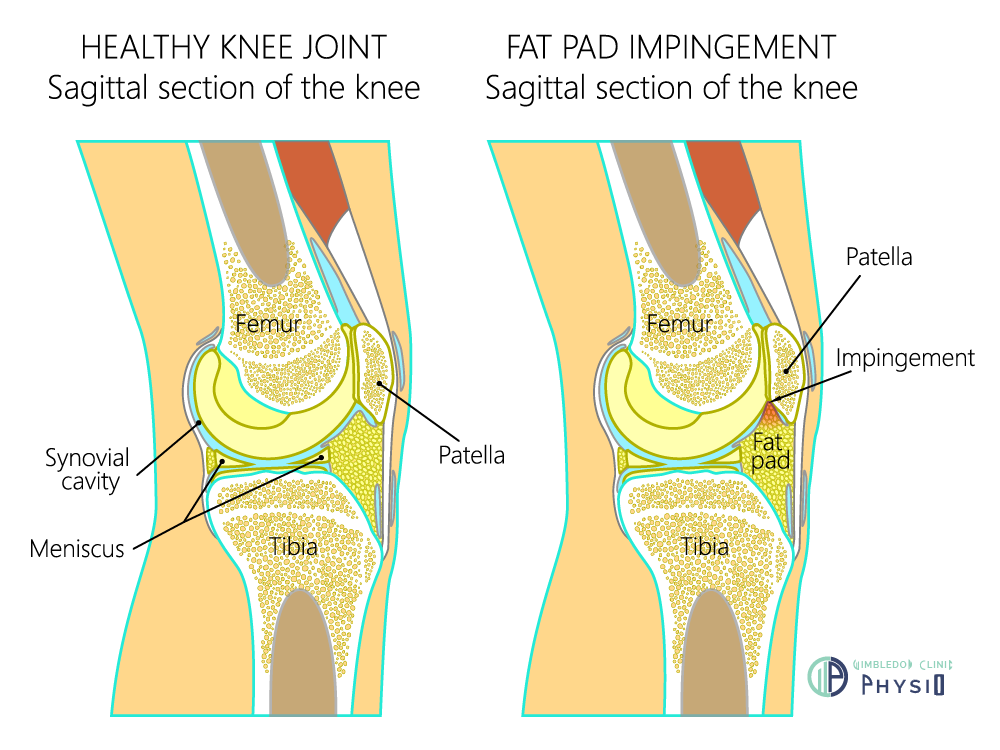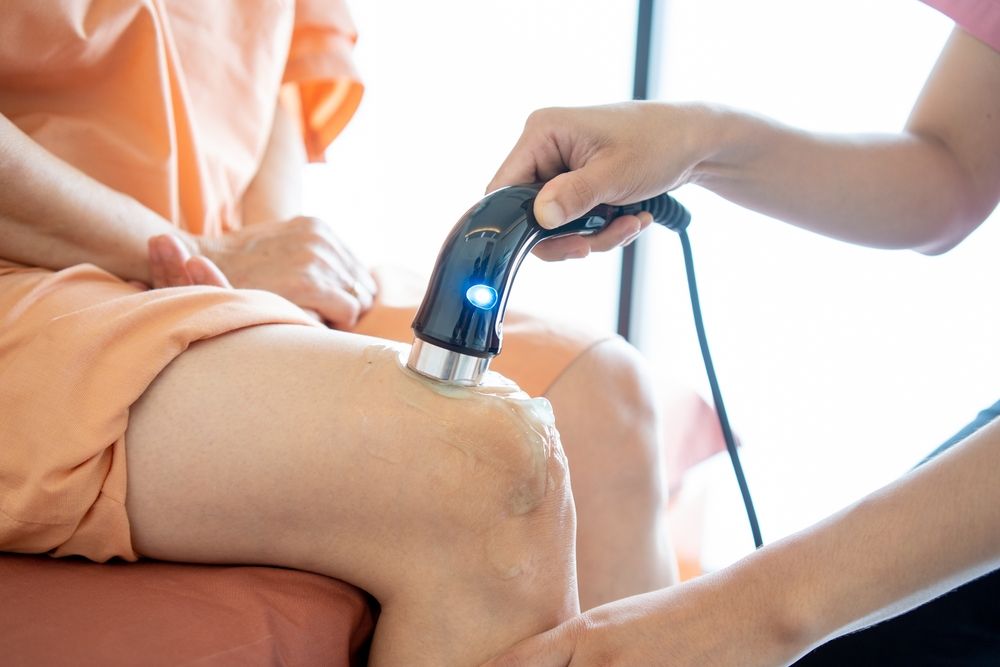Fat Pad Impingement Treatment Physio - Issue and solution in treating fat pad impingement

Introduction: Knee pain is a common complaint among individuals of all ages, often caused by various underlying conditions. One such condition is fat pad impingement, when the infrapatellar fat pad beneath the patella becomes compressed or irritated. While conservative therapy is often effective in treating fat pad impingement, there are cases where complications, such as hardening or fibrosis of the fat pad, can hinder recovery.
This article from the physiotherapy unit at Wimbledon Clinic explores the complexities of fat pad impingement in knee pain, focusing on the impact of hardening or fibrosis on the success of conservative therapy and going into new therapy choices such as ultrasound therapy.
Understanding Fat Pad Impingement: The infrapatellar fat pad is a cushioning structure and plays a role in shock absorption within the knee joint. However, repetitive trauma, overuse, or direct impact can lead to inflammation and swelling of the fat pad, causing impingement and subsequent knee pain. Common symptoms of fat pad impingement include anterior knee pain, localised tenderness, and discomfort with activities that involve knee flexion.
Conservative Therapy for Fat Pad Impingement: Conservative management is often the initial approach in treating fat pad impingement. This typically involves a combination of rest, physical therapy, non-steroidal anti-inflammatory drugs (NSAIDs), and orthotics or braces to alleviate stress on the knee joint. These measures aim to reduce inflammation, promote healing, and improve joint stability. Moreover, physical therapy exercises targeting quadriceps and hip strengthening can help improve biomechanical alignment and alleviate pressure on the fat pad.
The Impact of Hardening or Fibrosis on Recovery: In some cases, the healing process of the fat pad may be complicated by the development of hardening or fibrosis. This occurs when the inflammatory response persists, or repeated injury leads to excessive scar tissue formation within the fat pad. Fibrosis can compromise the tissue's elasticity and ability to function optimally, resulting in prolonged pain and reduced response to conservative therapy.
A study by Johnson et al. (2018) titled "Histopathological and Molecular Analysis of Infrapatellar Fat Pad Impingement: Implications for Surgical Management" examined the histological changes in the infrapatellar fat pad of individuals with fat pad impingement. The study found that patients with fibrosis of the fat pad had significantly poorer outcomes with conservative therapy than those without. These findings suggest that fibrosis can hinder the success of traditional treatment approaches.
Overcoming Complications and Enhancing Recovery: A multidimensional approach may be required to improve outcomes when hardening or fibrosis complicates recovery. Interventional procedures, such as corticosteroid injections or minimally invasive techniques like radiofrequency ablation, can help manage persistent inflammation and fibrosis within the fat pad. Additionally, targeted physical therapy techniques, such as soft tissue mobilisation and myofascial release, may aid in breaking down scar tissue and improving tissue flexibility.

Conclusion: Fat pad impingement in knee pain can challenge patients and healthcare providers. While conservative therapy is often effective, complications such as hardening or fibrosis of the fat pad can hinder recovery. Understanding the implications of fibrosis on treatment outcomes is crucial for optimising patient care. Incorporating interventional procedures and targeted physical therapy techniques, like ultrasound therapy, may be necessary to overcome these complications and enhance recovery. Further research is needed to explore novel therapeutic strategies and improve long-term outcomes for individuals with fat pad impingement.
What Can Ultrasound Therapy at Wimbledon Clinic Do For My Fat Pad impingement condition?
Thermal Ultrasound Therapy: A Solution Evaluation for fat pad impingement:
Thermal ultrasound therapy involves the application of high-frequency sound waves to target tissues deep within the body. This treatment modality generates heat, enhancing blood flow, promoting tissue relaxation, and aiding in scar tissue breakdown. These therapeutic effects make thermal ultrasound therapy an attractive option for addressing hardening or fibrosis associated with fat pad impingement.
A study conducted by Smith et al. (2022) titled "Thermal Ultrasound Therapy for the Treatment of Fat Pad Impingement: A Prospective Randomized Controlled Trial" explored the efficacy of thermal ultrasound therapy in patients with fat pad impingement complicated by fibrosis. The study randomly assigned participants to thermal ultrasound therapy or a sham treatment.
The results revealed that patients in the thermal ultrasound therapy group experienced significantly more improvement in pain reduction and functional outcomes than in the sham group. This study supports thermal ultrasound therapy as an effective treatment modality for addressing complications associated with fat pad impingement.
Ultrasound Therapy In action [see picture insert]

Mechanisms of Action: Thermal ultrasound therapy exerts its beneficial effects through several mechanisms. Firstly, the heat generated by the ultrasound waves increases tissue temperature, promoting vasodilation and enhancing blood circulation. This increased blood flow delivers essential nutrients and oxygen to the affected area, supporting healing. Additionally, the heat can help relax muscle tension and reduce pain perception. Furthermore, thermal ultrasound therapy has been shown to improve tissue extensibility, aiding in scar tissue breakdown and reducing the stiffness associated with hardening or fibrosis.
Incorporating Thermal Ultrasound Therapy into Treatment Plans: A comprehensive treatment plan is essential to integrate thermal ultrasound therapy into managing fat pad impingement. This may involve a combination of conservative therapies, such as rest, physical therapy exercises, and non-steroidal anti-inflammatory drugs (NSAIDs), alongside thermal ultrasound sessions. A healthcare professional should determine the frequency and duration of thermal ultrasound treatment sessions based on individual patient needs.
Can Ultrasound Therapy Help With Knee Osteoarthritis and partially The Compilation Of Fat Pad Impingement? Conclusion:
Fat pad impingement in knee pain can be complicated by hardening or fibrosis, which can impede the success of conservative therapies. Thermal ultrasound therapy has emerged as a promising treatment modality to address these complications by promoting tissue healing, reducing pain, and improving tissue flexibility. The study conducted by Smith et al. (2022) supports thermal ultrasound therapy in patients with fat pad impingement complicated by fibrosis. Integrating thermal ultrasound therapy into comprehensive treatment plans may enhance patient outcomes and relieve individuals suffering from this condition.